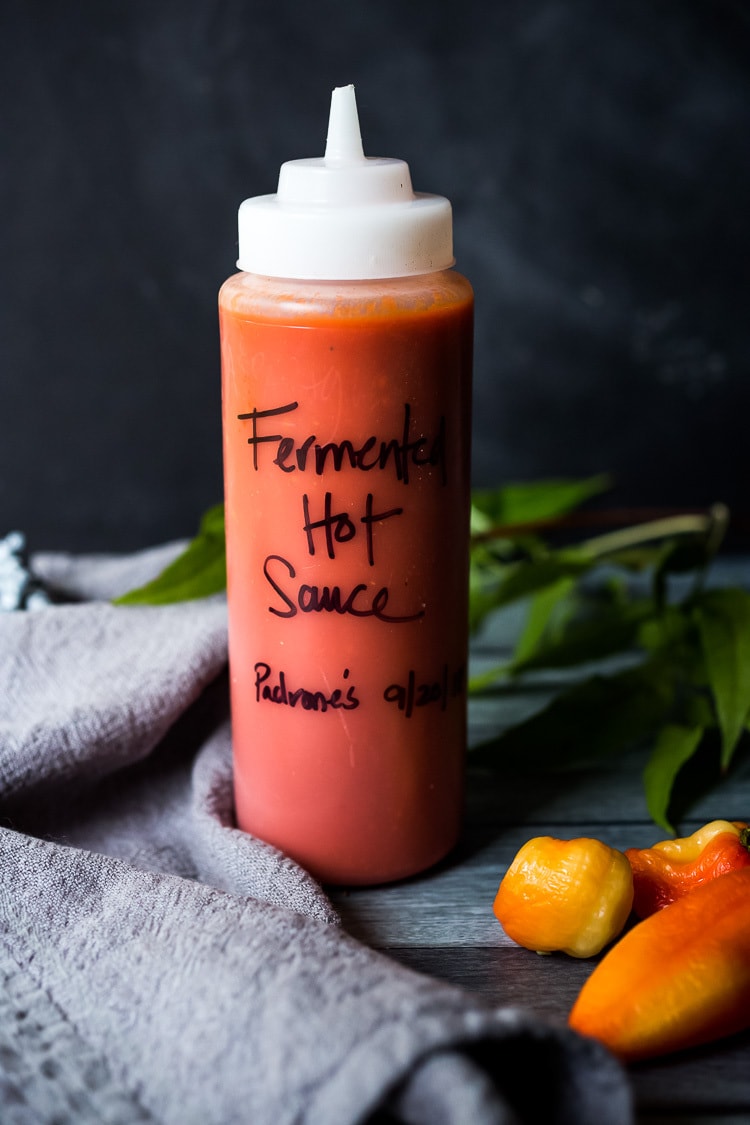Tender and delicately tangy crepes made with a sourdough starter.
Fermented Hot Sauce
The sourdough adds complexity and lifts the classic crepe to new heights. Be patient when you start to cook them, since just like pancakes, the first crepe is never the best as you get the hang of it.
Ingredients
Salt Water Brine:
- 5 cups filtered water, lukewarm
- 6 1/4 teaspoons finely ground sea salt (or Pink Himalayan salt) – use 1 1/4 teaspoon salt, per 1 cup of water.
Jar Fillings:
- 1 pound chili peppers, sliced in half (about 6–7 cups)
- 1 carrot, very thinly sliced (do not peel)
- 4–6 garlic cloves, cut in quarters
- 1–2 shallots, sliced (or ½ an onion)
- Optional: herbs (oregano, cilantro, celery leaves)
After fermenting, add optional seasonings to taste. Keep in mind the “heat” will mellow with age.
- 1–3 tablespoons apple cider vinegar, (optional- for extra tang and for more healthy probiotics)
- honey sugar to taste (optional, good if making Sriracha style)
- If your hot sauce is not hot enough, you can always add cayenne or ground chipotle to taste. Free free to add spices- cumin, coriander, allspice, etc. Make this your own.
Directions
- Heat the water and stir the sea salt into the warm water until dissolved. Let cool to room temp.
- Wearing gloves, slice the small hot peppers in half, and remove stems and seeds if you like (for less heat). I left the seeds in mine. If adding bell peppers to temper the heat, cut into thin strips. Thinly slice the carrot (do not peel), slice the shallots and slice the garlic.
- Layer all into a 2 quart jar. Pour the salt water brine into the jar over the chilies, pressing them down under the liquid. If you need to add more brine, remember to use the ratio of 1 teaspoon salt per 1 cup of water.
- Weight the chilies down with canning weights (or use a small ziplock bag filled with water, to weigh the veggies down). You want the veggies completely submerged under the brine. Cover lightly with a lid and place the jar in a pan or bowl to collect any liquid that may spill over.
- Place in a cool dark place (or cover with a kitchen towel and leave in a cool kitchen) for 5-7 days or until brine appears slightly cloudy. Tap the container and see if there is any activity, bubbles, or effervescence.
- After 5-7 days, strain the brine, saving it. Place the fermented peppers, onions, garlic and carrot into a blender. Add 1 cup of the brine and blend until smooth as smooth as possible. Add the vinegar if using, (and sugar if you prefer a sweeter hot sauce like Sriracha), and more brine to desired thickness.
- The heat level will mellow a bit with time, as it continues to ferment in the fridge.
- Place in a squeeze bottle and store in the fridge. Do not place in a sealed jar unrefrigerated– this will result in an explosion– and great big mess- as sauce is still fermenting! BE WARNED!
- I have the best luck with using in squeeze bottles and leaving the cap off in the fridge. Cover opening with your finger and shake before using.
- If transporting to a friend as a gift, it is ok to seal for short periods of time (a few hours) but make sure they “burp” it and refridgerate it pretty soon after receiving.
- The flavors will continue to develop and get more complex over time, the heat mellowing.
- This will keep up to 12 months in the fridge (probably even longer).
- To use, store in a squeeze bottle. Leave tip open in the fridge. Cover tip with finger and give a good shake before using.
- Regular tap water may contain too much chlorine in it, inhibiting the fermentation process. Try to use filtered water if possible.
- I use fine ground sea salt or Pink Himalayan salt . If using coarse ground salt you may need to add a pinch more.
- Use any chili pepper you like, or a blend of different peppers (in the same color palate) . To temper the heat, feel free to add a similar colored bell pepper. Substitute sweet red, yellow or green bell pepper. Keep in mind, you will be blending the sauce, so I prefer to stick with the same color scheme to make a vibrant colored sauce. For example, I prefer not to mix red and green peppers (which equal brown) but up to you. Also, keep in mind, the fermentation will mellow the heat a little.
- If you need more water to cover or fill the jar, use 1 teaspoons salt per cup of warm water.
- You could easily halve this recipe or use two, quart-sized jars.

